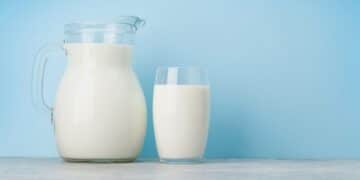Milk is one of the most consumed beverages in the world. After all, it’s nutritious and tastes good, especially when you add it to your morning cup of coffee!
Other than being a healthy beverage, though, there’s more to know about milk, like why it appears white and how a chemical compound found in fermented milk can benefit your skin!
With that said, prepare to enrich your mind with these 35 useful facts about milk:
Milk taken from cows at night has higher levels of tryptophan and melatonin — both substances that play a crucial role in promoting sleep.
Milk consists of 87% water. The remaining 13% is divided into protein, fat, carbohydrates, vitamins, and minerals.
Cow’s milk is the most commonly consumed type of milk since cows produce more milk daily than other mammals.
Raw milk can carry harmful bacteria, but it can be removed through a process called pasteurization.
The FDA prohibited selling raw milk between states in 1987. Some states, such as California, Ohio, and Utah, have since legalized the sale of raw milk.
Goat milk has more calories and is more nutrient-rich than cow’s milk. On top of that, there’s also less lactose in goat milk when compared to the most popular type of milk.
The irrational fear of milk is referred to as galaphobia. An example of someone who has this strange phobia is NFL player Will Levis, who screams at the mere sight of milk!
Milk is a remarkably good alternative to sports drinks, like Gatorade, since milk is also high in electrolytes.
Casein and whey protein are the two types of protein found in cow’s milk. They’re considered high-quality proteins as they both contain amino acids.
Soaking fish in milk can make it smell much less fishy. This miraculous reaction is down to the milk proteins binding to trimethylamine — the compound causing that unpleasant fishy smell.
The reason why milk looks white is because the fat and protein in it scatter light.
Skim milk, though, appears bluish since there is less fat in it to create whole milk’s milky-white appearance.
Drinking milk that has casein (most dairy-free milk doesn’t have any) reduces the burning sensation you feel after eating spicy food. Milk products like yogurt or cream also work wonders.
A breast infection called mastitis can make breast milk taste salty rather than sweet.
Two of the most popular plant-based milks are soy and almond milk. Neither of them contains lactose, making them great alternatives for people who are allergic to milk or are lactose intolerant.
To teach kids generosity (and gratefulness for the Christmas gifts they received) during the Great Depression, parents encouraged them to leave milk and cookies for Santa.
Spoiled milk can be used in baking because it’s highly acidic — acidic ingredients make baked goods more flavorful.
Lactose is a chemical naturally found in milk and other dairy products. Lactase, on the other hand, is an enzyme produced in the small intestine that helps break down lactose.
When someone is lactose intolerant, it means that their body doesn’t produce enough lactase. Fortunately, there are lactase pills for when someone with lactose intolerance really wants to drink milk or eat some cheese!
Milk is beneficial for your teeth because it contains high amounts of calcium, which is known for strengthening your enamel and helping your teeth fight off cavities.
Red wine stains can be removed with milk. All you need to do is soak the affected area with milk until the stain lifts away, then wash it as usual.
National Milk Day in the US is celebrated on January 11. But for India, it’s celebrated on November 26.
In 2001, the Food and Agriculture Organisation of the United Nations (FAO) created World Milk Day to highlight the significance of milk and the dairy industry. It’s celebrated every year on June 1.
People who chug large amounts of milk tend to puke because there’s too much lactose for the body’s lactase to break down.
There’s a blue-green-colored milk that’s made from algae called Spirulina, which is also high in protein and minerals.
In Star Wars, there are two fictional milks that are colored blue and green. Recreations of both are available at Star Wars Galaxy’s Edge in Florida’s Disney World and California’s Disneyland.
There’s a term used when you make a beverage out of Pepsi and milk. It’s called “Pilk,” and its taste is said to be identical to an ice cream float.
Don’t throw out your expired milk – it can be used for watering plants due to its calcium, a nutrient that’s crucial for plant growth.
Evaporated milk is created by evaporating 60% of the water in milk. The same percentage of water is removed when making condensed milk, but the difference with this type of milk is the added sugar.
Out of all the kinds of plant-based milk, unflavored oat milk has the most calories and carbohydrates.
Milk-based paint dries faster than oil-based paint and is used to make furniture look chipped or vintage. Some cave drawings done over 6,000 years ago used milk paint.
The lactic acid that’s produced by fermenting milk is used in skincare products, as it helps remove dead skin cells and moisturize the skin. Most skincare products use lactic acid from beet sugar or cornstarch, though.
Lactobacillus acidophilus, a so-called good bacteria due to its beneficial properties, is found in milk. It’s responsible for turning lactose into lactic acid, as well as causing the drink to taste sour.
Some countries, such as Canada and Sweden, mandate that cow’s milk should be fortified with vitamin D. Vitamin D is an essential nutrient, especially when it comes to milk, as it helps your body absorb calcium.
Milk is able to cover coffee’s bitterness by binding the proteins in milk with the polyphenol compounds (like tannins) that cause its bitterness. Also, coffee becomes creamier thanks to the fats found in milk.

The milk most people drink usually comes from animals. But thankfully, there are many kinds of vegan-friendly milk in the market, which also offer the same nutrients.
Its color can vary as well. Most milk drinks are white, while some are colored differently — the reason ranges from having less fat content to imitating fictional milk.
There’s no denying that milk is nutritious. That’s why drinking it is a no-brainer… unless you have lactose intolerance or milk allergy, of course.
Remember all these facts the next time you drink milk, so you’ll know exactly why it benefits your health. And make sure to tell your family and friends about it, especially on National Milk Day!


















